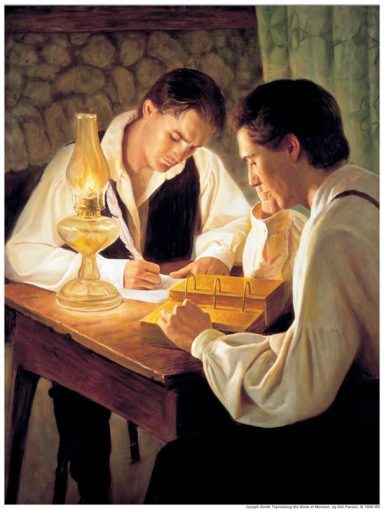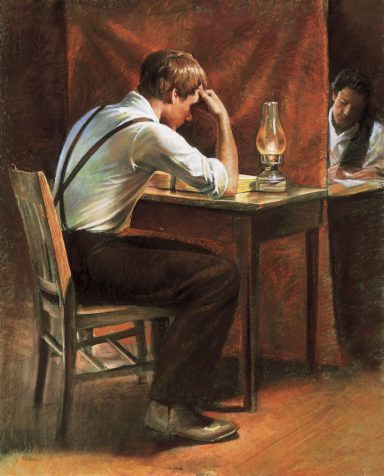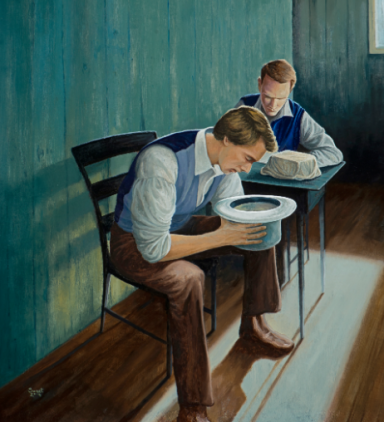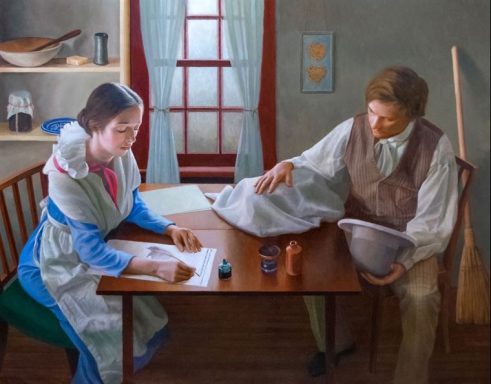
Translation
of the Golden Plates
Throughout the Church's history, the leaders have tried to weed out Joseph Smith's use of the seer stone as part of the translation process. Only until recently, have they integrated the "rock in a hat" back into the history.
Timeline
Joseph obtains the plates, Summer 1827
In the summer of 1827, Joseph Smith retrieved the plates with his wife, Emma. Some sources say that he did so in the middle of the night, dressed all in black, while using a black horse.
Lost 116 Pages, Summer of 1828
At the beginning of the translation process Joseph Smith worked with a man named Martin Harris. Excited by the prospect of showing his friends and family, Martin pleaded with Joseph to let him take the manuscript home. After hearing his pleadings, Joseph finally allowed Martin to take the pages home. Shortly after, Martin Harris lost the 116 pages. They were never recovered.
Mosiah III-Moroni, April 1829 - June 11, 1829
After nine months, Joseph again began the translation process, this time starting at Mosiah III (or what is now Mosiah chapter one). Joseph completed the majority of the translation with a man named Oliver Cowdery.
Copyright, June 11, 1829
Joseph and Oliver translate the Title Page which they sent in to be copyrighted. By their description, the Title Page of the Book of Mormon was then on the "last leaf on the left hand side" of the plates. This would indicate that they had translated every part of the Golden Plates except for what was said to be "sealed."
1 Nephi - Mosiah II, c June 11, 1829 - June 30, 1829
Joseph and Oliver translate last what is now the beginning of the Book of Mormon. Theories abound concerning what Joseph Smith actually translated here. Was it another set of plates? Was it simply inspiration? Was it another part of the initial plates Joseph pulled from the Hill Cumorah, even though they'd translated it in its entirety, as indicated by the Title Page?
At some point after the translation, according to many (including David Whitmer, Brigham Young and Orson Pratt), Joseph Smith returned the plates to the Hill Cumorah into what is known as Moroni's Repository. Although the Church today has many of Joseph's seer stones, they do not have the golden plates.
March 1830
The Book of Mormon is finally printed.
How did Joseph Smith Translate the Gold Plates
There are different versions of the translation process. But which is correct?
A Literal Translation
Emma Smith
1856 (published in 1916)
“When my husband was translating the Book of Mormon, I wrote a part of it, as he dictated each sentence, word for word, and when he came to proper names he could not pronounce, or long words, he spelled them out, and while I was writing them, if I made any mistake in spelling, he would stop me and correct my spelling, although it was impossible for him to see how I was writing them down at the time. …
“When he stopped for any purpose at any time he would, when he commenced again, begin where he left off without any hesitation.”
Emma Smith, in Edmund C. Briggs, “A Visit to Nauvoo in 1856,” Journal of History, vol. 9, no. 4 (Oct. 1916), 454.
Also cited on the Church's website under "The Translation of the Book of Mormon"


A Literal Translation
David Whitmer
1887
I will now give you a description of the manner in which the Book of Mormon was translated. Joseph Smith would put the seer stone into a hat and put his face in the hat, drawing it closely around his face to exclude the light; and in the darkness the spiritual light would shine, A piece of something resembling parchment would appear, and on that appeared the writing. One character at a time would appear, and under it was the interpretation in English. Brother Joseph would read off the English to Oliver Cowdery, who was his principal scribe, and when it was written down and repeated to Brother Joseph to see if it was correct, then it would disappear, and another character with the interpretation would appear. Thus the Book of Mormon was translated by the gift and power of God, and not by any power of man.
No Stone in a Hat?
This is one of my Tik Tok videos where I demonstrate how the Church has whitewashed the "stone in a hat" from its history. They did NOT teach that Joseph Smith translated the golden plates with his seer stone in his white top hat.
Was there a screen, blanket, or curtain?

Emma Smith
1879
Martin Harris is the only scribe that describes having a screen, blanket, or curtain separating himself and Joseph during the translation process.
Emma Smith said that "I frequently wrote day after day, often sitting at the table close by him, he sitting with his face buried in his hat, with the stone in it, and dictating hour after hour with nothing between us."
[Joseph Smith III, “Last Testimony of Sister Emma;’ Saints’ Herald 26 (October 1, 1879): 289-90]
Elizabeth Ann
Whitmer Cowdery
1870
William McLellin relayed a "certificate" that he got from "widow Cowdery" meaning Elizabeth Ann Whitmer.
William stated that: "I staid in Richmond two days and nights. I had a great deal of talk with widow Cowdry, and her amiable daughter. She is married to a Dr Johnson, but has no children. She gave me a certificate, And this is the copy. 'Richmond, Ray Co., Mo. Feb 15, 1870———I cheerfully certify that I was familiar with the manner of Joseph Smith’s translating the book of Mormon. He translated the most of it at my Father’s house. And I often sat by and saw and heard them translate and write for hours together. Joseph never had a curtain drawn between him and his scribe while he was translating. He would place the director in his hat, and then place his face in his hat, so as to exclude the light, and then [read the words?] as they appeared before him.'"
[William E. McLellin to “My Dear Friends,” February 1870, Community of Christ Library-Archives]


Martin Harris
(John A. Clark)
1842
In his book, Gleanings By The Way, John A. Clark tells the following:
"The way that Smith made his transcripts and translations for Harris was the following. Although in the same room, a thick curtain or blanket was suspended between them, and Smith concealed behind the blanket, pretended to look through his spectacles, or transparent stones, and would then write down or repeat what he saw, which, when repeated aloud, was written down by Harris, who sat on the other side of the suspended blanket. Harris was told that it would arouse the most terrible divine displeasure, if he should attempt to draw near the sacred chest, or look at Smith while engaged in the work of decyphering the mysterious characters. This was Harris's own account of the matter to me. What other measures they afterwards took to transcribe or translate from these metallic plates, I cannot say, as I very soon after this removed to another field of labour where I heard no more of this matter till I learned the Book of Mormon was about being published."
W. R. Hine
1888
In 1888, W. R. Hine gave a statement that was published in "Naked Truths About Mormonism." He says:
"Soon I learned that Jo claimed to be translating the plates in Badger’s Tavern, in Colesville, three miles from my house. I went there and saw Jo Smith sit by a table and put a handkerchief to his forehead and peek into his hat and call out a word to Cowdery, who sat at the same table and wrote it down. Several persons sat near the same table and there was no curtain between them. Martin Harris introduced himself to me, and said they were going to bring the world from darkness into light."
[W. R. Hine’s Statement, Naked Truths about Mormonism 1 (January 1888) 2

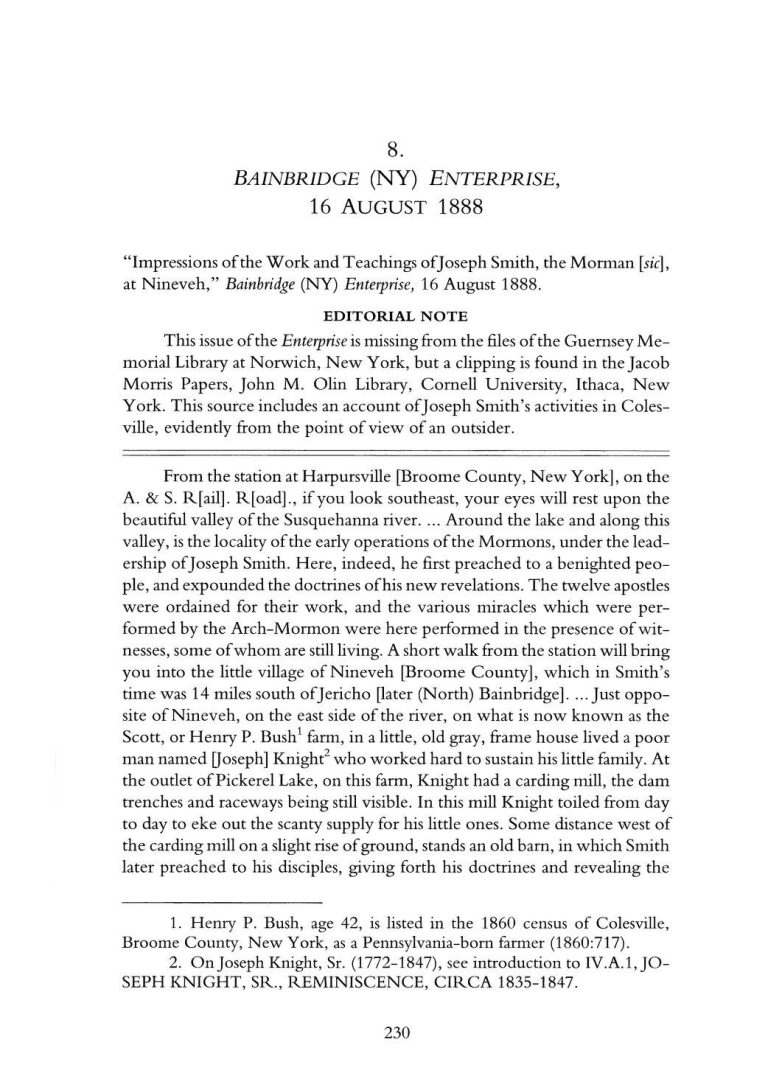
Enterprise
16 August 1888
From an issue of the Enterprise published on August 16, 1888 a story ran called "Impressions of the Work and Teachings of Joseph Smith, the Morman [sic], at Nineveh." This source incldues an account of Joseph Smith's activiites in Colesville, evidently from the point of view of an outsider. The article reads in part:
"No person would be allowed to see these plates, as no person could look at them and live. He had a large roll of paper rolled up in a valise which he carried with him, which he claimed to Knight was a translation from these plates and constituted the revelation. He farther showed this manuscript to Knight, which he claimed was translated by himself by looking through the Urim and Thummim while he sat behind a blanket hung across a room in order that the sacred records might be kept from profane eyes, and read off the 'Book of Mormon,' or Golden Bible as he sometimes called it, to Oliver Cowdery 4 who wrote it down."
Unique Words
in the Book of Mormon
Many believe that because the Book of Mormon has words that are unique and that are more than two syllables that there's no way Joseph Smith could have written it. Below is a list of some of the unique words and where, perhaps, Joseph Smith could have seen them.
"Interposition"
In the 1828 edition of Webster's Dictionary the word "interposition" means (1) A being, placing or coming between; intervention; (2) Intervenient agency; as the interposition of the magistrate in quieting sedition. How many evidences have we of divine interposition in favor of good men!
The word "interposition" appears only once in the Book of Mormon. In Mosiah 29:19 it reads:
And were it not for the interposition of their all-wise Creator, and this because of their sincere repentance, they must unavoidably remain in bondage until now.

The word "interposition" is used many times among Joseph Smith's peers (Emma Smith, Lucy Mack Smith, Lewis Zeigler, W. W. Phelps, Horace Hotchkiss, etc.) Additionally, the list below is only reflective of the word "interposition" and not "interpose" or "interposed" which would add many more. Joseph Smith used the word a few times as well, including in his letter to James Arlington Bennet on March 17, 1843. Because the word is so often used, especially by close family, it seems likely that this word is not "unique" to this farm boy, but rather a common word in his vocabulary.
Letter from Horace Hotchkiss, 17 March 1840, Page 118
Journal, December 1841–December 1842, Page 192
History, 1838–1856, volume A-1
History, 1838–1856, volume C-1
History Draft [1 January–3 March 1843], Page 7
Council of Fifty, Minutes, March 1844–January 1846; Volume 2, 1 March–6 May 1845, Page 117
Lucy Mack Smith, History, 1845, Page 207
History, 1838–1856, volume F-1 [1 May 1844–8 August 1844], Page 269
Council of Fifty, Minutes, March 1844–January 1846; Volume 2, 1 March–6 May 1845, Page 117
Letterbook 2, Page 130
Letterbook 1, Page 59
Letter to James Arlington Bennet, 17 March 1843, Page 1
Letter from Emma Smith, 7 March 1839, Page 37
Letter from Lewis Zeigler, 25 May 1844, Page 1
Letter from William W. Phelps, 15 December 1833, Page 128
Memorial to the United States Senate and House of Representatives, 28 November 1843, Page 3
Parley P. Pratt et al., “‘The Mormons’ So Called,” 12 December 1833, Page 2
Appendix: Report of the United States Senate Committee on the Judiciary, 4 March 1840, Page 2
Letter from Edward Partridge, between 14 and 19 November 1833, Page 1

"Faculty"
In the 1828 edition of Webster's Dictionary the word "faculty" means (1) That power of the mind or intellect which enables it to receive (such as seeing, hearing, imagining, remembering, etc.) and (2) The power of doing any thing; ability.
The word "faculty" appears only once in the Book of Mormon. In Words of Mormon 1:18 it reads:
Wherefore, with the help of these, king Benjamin, by laboring with all the might of his body and the faculty of his whole soul, and also the prophets, did once more establish peace in the land.
Lucy Mack Smith, Joseph's mother, uses the word in her own history in a very interesting way. She says:
I shall change my theme for the present but let not my reader suppose that because I shall pursue another topic for a season that we stopt our labor and went <at> trying to win the faculty of Abrac drawing Magic circles or sooth saying to the neglect of all kinds of buisness we never during our lives suffered one important interest to swallow up every other obligation but whilst we worked with our hands we endeavored to remmember the service of & the welfare of our souls.
In the book "A New and Complete Illustration of the Occult Sciences" by Ebenezer Sibly, a book which historian D. Michael Quinn places in the hands of the Smith family, the word "faculty" appears 47 times. The word "faculty" was often used by Joseph Smith and his peers, such as Lucy Mack Smith, Oliver Cowdery, Udney H. Jacob, Sylvester Emmons, S. J. Wild, Daniel H. Wells, Joseph Smith used it in a letter to Noah C. Saxton as well as many times in the Times and Seasons newspaper. Again, it seems likely that this word is not "unique" to this farm boy, but rather a common word in his vocabulary. It is interesting that the word does not appear in any Mormon-specific scriptures (Doctrine and Covenants, Book of Commandments or the Pearl of Great Price).
Times and Seasons, 1 June 1842, Page 799
Journal, December 1842–June 1844; Book 1, 21 December 1842–10 March 1843, Page 7
Blessing to Lorenzo Booth, 1 March 1835, Page 171
Lucy Mack Smith, History, 1845, Page 312
History, 1838–1856, volume A-1 [23 December 1805–30 August 1834], Page 534
History, 1838–1856, volume C-1 [2 November 1838–31 July 1842], Page 1360
Lucy Mack Smith, History, 1844–1845, Page [10], bk. 3
Minute Book 1, Page 171
Letterbook 2, Page 116
Letterbook 1, Page 14
Letter from Udney H. Jacob, 6 January 1844, Page 3
Letter from Sylvester Emmons, 29 January 1843, Page 2
Letter from Oliver Cowdery, 8 April 1831, Page 11
Letter to Noah C. Saxton, 4 January 1833, Page 14
Minutes and Blessings, 28 February–1 March 1835, Page 171
Appendix 3: Discourse, circa 4 July 1838, Page 9
Times and Seasons, 15 October 1842, Page 947
Letter from S. J. Wild, 30 April 1843, Page 2
Appendix: Wasp, Extra, 27 July 1842, Page 3
Times and Seasons, 1 March 1842, Page 712
Times and Seasons, 15 March 1842, Page 726
Times and Seasons, 1 August 1842, Page 874
Times and Seasons, 1 July 1842, Page 842

"Appellation"
In the 1828 edition of Webster's Dictionary "appellation" means "Name; the word by which a thing is called and known."
The word "appellation" appears only once in the Book of Mormon. In Alma 51:21 it reads:
And thus Moroni put an end to those king-men, that there were not any known by the appellation of king-men; and thus he put an end to the stubbornness and the pride of those people who professed the blood of nobility; but they were brought down to humble themselves like unto their brethren, and to fight valiantly for their freedom from bondage.
While the word "appellation" does not appear in the King James Bible, it was used among Joseph Smith's peers. The word does not appear anywhere in any other Mormon-specific scriptures (Doctrine and Covenants, Book of Commandments or Pearl of Great Price).
History, 1838–1856, volume B-1,
History, 1838–1856, volume A-1,
Letter from Francis Gladden Bishop, 26 September 1843,
The Reflector, January 13, 1830
"Ignominious"
In the 1828 edition of Webster's Dictionary "ignominious" means (1) incurring disgrace; cowardly; of mean character. (2) Very shameful; reproachful; dishonorable; infamous. (3) Despicable; worthy of contempt; as an ignominious projector.
In Alma 1:15, from the Book of Mormon it reads:
And it came to pass that they took him; and his name was Nehor; and they carried him upon the top of the hill Manti, and there he was caused, or rather did acknowledge, between the heavens and the earth, that what he had taught to the people was contrary to the word of God; and there he suffered an ignominious death.

In the 1823 Bible purchased by Joseph Smith and Oliver Cowdery on October 8, 1829, the word "ignominy" appears in Proverbs 18:3. It is also important to note that the Book of Mormon only has the word only once and it does not appear again anywhere in any other Mormon-specific scriptures (Doctrine and Covenants, Book of Commandments or Pearl of Great Price).
The word does not appear in any other Mormon-specific scriptures (Doctrine and Covenants, Book of Commandments, or Pearl of Great Price). The word does appear in the minutes for the Council of Fifty and the History of the Church Volume E-1.
The word "ignominious" also appears four times in the book "A New and Complete Illustration of the Occult Sciences" by Ebenezer Sibly, a book which historian D. Michael Quinn places in the hands of the Smith family.

"Prick"
Psalms 73:21 (pricked)
Numbers 33:55 (pricks)
Ezekiel 28:24 (pricking)
Acts 2:37 (pricked)
Acts 9:5 (pricks)
Acts 26:14 (pricks)
In the 1828 edition of Webster's Dictionary the word "prick" means "To pierce with a sharp pointed instrument or substance; as, to prick one with a pin, a needle, a thorn or the like."
This word also appears only once in the Book of Mormon and the way it is used is exactly how it is used elsewhere in the Bible. In Jarom 1:12 it reads:
And it came to pass that by so doing they kept them from being destroyed upon the face of the land; for they did prick their hearts with the word, continually stirring them up unto repentance.
The word "prick" actually shows up several times in the King James Bible.
It is also important to note that the word "prick" does not appear in any of the other Mormon-specific standard works. It does not appear in the Doctrine and Covenants, Pearl of Great Price, or Book of Commandments. While some have seen this non-repetition of words as evidence that Joseph truly was translating an ancient text, it could just as easily be indicative of the author not fully understanding the meaning of the word.
© Copyright. All rights reserved.
We need your consent to load the translations
We use a third-party service to translate the website content that may collect data about your activity. Please review the details in the privacy policy and accept the service to view the translations.
